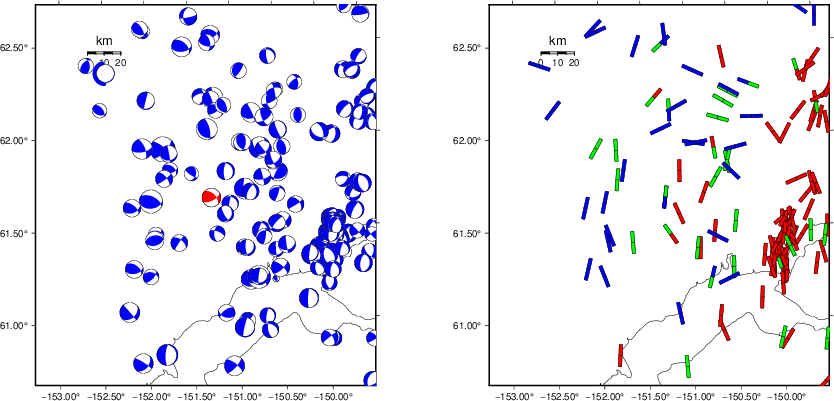Location
Location ANSS
The ANSS event ID is ak0128mxrejd and the event page is at
https://earthquake.usgs.gov/earthquakes/eventpage/ak0128mxrejd/executive.
2012/07/06 01:22:04 61.677 -151.274 84.8 4.7 Alaska
Focal Mechanism
USGS/SLU Moment Tensor Solution
ENS 2012/07/06 01:22:04:0 61.68 -151.27 84.8 4.7 Alaska
Stations used:
AK.BRLK AK.CNP AK.FIB AK.GHO AK.HOM AK.PPLA AK.RC01 AK.SAW
AK.SCM AK.SKN AK.SSN AT.PMR
Filtering commands used:
hp c 0.02 n 3
lp c 0.06 n 3
Best Fitting Double Couple
Mo = 1.19e+23 dyne-cm
Mw = 4.65
Z = 87 km
Plane Strike Dip Rake
NP1 65 65 40
NP2 315 54 149
Principal Axes:
Axis Value Plunge Azimuth
T 1.19e+23 45 285
N 0.00e+00 44 92
P -1.19e+23 6 188
Moment Tensor: (dyne-cm)
Component Value
Mxx -1.11e+23
Mxy -3.06e+22
Mxz 2.82e+22
Myy 5.28e+22
Myz -5.56e+22
Mzz 5.85e+22
--------------
----------------------
----------------------------
##########--------------------
################------------------
####################----------------
#######################---------------
##########################------------##
######## #################--------####
######### T ##################------######
######### ####################--########
################################-#########
#############################-----########
#########################--------#######
#####################-------------######
###############-------------------####
---------------------------------###
--------------------------------##
------------------------------
----------------------------
------- ------------
--- P --------
Global CMT Convention Moment Tensor:
R T P
5.85e+22 2.82e+22 5.56e+22
2.82e+22 -1.11e+23 3.06e+22
5.56e+22 3.06e+22 5.28e+22
Details of the solution is found at
http://www.eas.slu.edu/eqc/eqc_mt/MECH.NA/20120706012204/index.html
|
Preferred Solution
The preferred solution from an analysis of the surface-wave spectral amplitude radiation pattern, waveform inversion or first motion observations is
STK = 65
DIP = 65
RAKE = 40
MW = 4.65
HS = 87.0
The NDK file is 20120706012204.ndk
The waveform inversion is preferred.
Magnitudes
Given the availability of digital waveforms for determination of the moment tensor, this section documents the added processing leading to mLg, if appropriate to the region, and ML by application of the respective IASPEI formulae. As a research study, the linear distance term of the IASPEI formula
for ML is adjusted to remove a linear distance trend in residuals to give a regionally defined ML. The defined ML uses horizontal component recordings, but the same procedure is applied to the vertical components since there may be some interest in vertical component ground motions. Residual plots versus distance may indicate interesting features of ground motion scaling in some distance ranges. A residual plot of the regionalized magnitude is given as a function of distance and azimuth, since data sets may transcend different wave propagation provinces.
ML Magnitude

Left: ML computed using the IASPEI formula for Horizontal components. Center: ML residuals computed using a modified IASPEI formula that accounts for path specific attenuation; the values used for the trimmed mean are indicated. The ML relation used for each figure is given at the bottom of each plot.
Right: Residuals from new relation as a function of distance and azimuth.

Left: ML computed using the IASPEI formula for Vertical components (research). Center: ML residuals computed using a modified IASPEI formula that accounts for path specific attenuation; the values used for the trimmed mean are indicated. The ML relation used for each figure is given at the bottom of each plot.
Right: Residuals from new relation as a function of distance and azimuth.
Context
The left panel of the next figure presents the focal mechanism for this earthquake (red) in the context of other nearby events (blue) in the SLU Moment Tensor Catalog. The right panel shows the inferred direction of maximum compressive stress and the type of faulting (green is strike-slip, red is normal, blue is thrust; oblique is shown by a combination of colors). Thus context plot is useful for assessing the appropriateness of the moment tensor of this event.
Waveform Inversion using wvfgrd96
The focal mechanism was determined using broadband seismic waveforms. The location of the event (star) and the
stations used for (red) the waveform inversion are shown in the next figure.
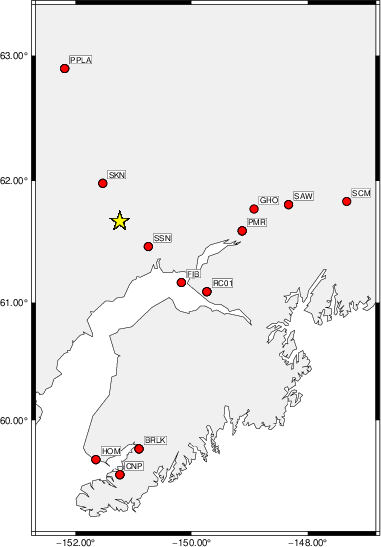
|
|
Location of broadband stations used for waveform inversion
|
The program wvfgrd96 was used with good traces observed at short distance to determine the focal mechanism, depth and seismic moment. This technique requires a high quality signal and well determined velocity model for the Green's functions. To the extent that these are the quality data, this type of mechanism should be preferred over the radiation pattern technique which requires the separate step of defining the pressure and tension quadrants and the correct strike.
The observed and predicted traces are filtered using the following gsac commands:
hp c 0.02 n 3
lp c 0.06 n 3
The results of this grid search are as follow:
DEPTH STK DIP RAKE MW FIT
WVFGRD96 0.5 85 40 65 3.82 0.1913
WVFGRD96 1.0 60 80 15 3.75 0.1967
WVFGRD96 2.0 55 90 20 3.87 0.2726
WVFGRD96 3.0 35 70 25 3.93 0.3091
WVFGRD96 4.0 35 75 20 3.95 0.3325
WVFGRD96 5.0 40 90 25 3.98 0.3553
WVFGRD96 6.0 45 85 25 4.01 0.3774
WVFGRD96 7.0 45 85 25 4.03 0.3961
WVFGRD96 8.0 45 85 25 4.07 0.4113
WVFGRD96 9.0 225 90 -25 4.08 0.4211
WVFGRD96 10.0 235 90 -25 4.12 0.4338
WVFGRD96 11.0 55 85 25 4.13 0.4481
WVFGRD96 12.0 55 85 25 4.14 0.4584
WVFGRD96 13.0 55 90 25 4.15 0.4666
WVFGRD96 14.0 55 90 25 4.16 0.4732
WVFGRD96 15.0 55 90 20 4.18 0.4796
WVFGRD96 16.0 55 90 20 4.19 0.4847
WVFGRD96 17.0 55 90 20 4.19 0.4889
WVFGRD96 18.0 55 90 20 4.20 0.4935
WVFGRD96 19.0 60 85 20 4.22 0.4971
WVFGRD96 20.0 60 85 20 4.23 0.5011
WVFGRD96 21.0 240 90 -20 4.24 0.5025
WVFGRD96 22.0 60 85 20 4.25 0.5068
WVFGRD96 23.0 240 90 -20 4.26 0.5083
WVFGRD96 24.0 240 90 -20 4.27 0.5105
WVFGRD96 25.0 60 85 20 4.27 0.5145
WVFGRD96 26.0 240 90 -20 4.28 0.5151
WVFGRD96 27.0 60 85 20 4.28 0.5181
WVFGRD96 28.0 60 85 20 4.29 0.5196
WVFGRD96 29.0 60 85 20 4.30 0.5210
WVFGRD96 30.0 240 90 -20 4.31 0.5220
WVFGRD96 31.0 240 90 -20 4.32 0.5228
WVFGRD96 32.0 240 90 -20 4.33 0.5236
WVFGRD96 33.0 240 90 -20 4.34 0.5246
WVFGRD96 34.0 60 90 20 4.34 0.5250
WVFGRD96 35.0 60 90 20 4.35 0.5250
WVFGRD96 36.0 60 90 20 4.36 0.5245
WVFGRD96 37.0 240 90 -20 4.38 0.5240
WVFGRD96 38.0 240 90 -20 4.39 0.5231
WVFGRD96 39.0 60 90 20 4.40 0.5222
WVFGRD96 40.0 60 90 30 4.45 0.5226
WVFGRD96 41.0 240 90 -25 4.46 0.5189
WVFGRD96 42.0 60 90 25 4.46 0.5159
WVFGRD96 43.0 60 90 25 4.47 0.5132
WVFGRD96 44.0 60 85 30 4.47 0.5106
WVFGRD96 45.0 60 85 30 4.48 0.5084
WVFGRD96 46.0 60 85 30 4.48 0.5066
WVFGRD96 47.0 60 85 30 4.49 0.5057
WVFGRD96 48.0 60 85 30 4.50 0.5054
WVFGRD96 49.0 60 85 30 4.50 0.5049
WVFGRD96 50.0 65 65 35 4.50 0.5079
WVFGRD96 51.0 65 65 35 4.51 0.5120
WVFGRD96 52.0 65 65 35 4.51 0.5158
WVFGRD96 53.0 65 65 35 4.52 0.5199
WVFGRD96 54.0 65 65 35 4.53 0.5251
WVFGRD96 55.0 65 65 35 4.53 0.5308
WVFGRD96 56.0 65 65 35 4.54 0.5360
WVFGRD96 57.0 65 65 35 4.54 0.5408
WVFGRD96 58.0 65 65 35 4.55 0.5466
WVFGRD96 59.0 65 65 35 4.55 0.5515
WVFGRD96 60.0 65 65 35 4.56 0.5558
WVFGRD96 61.0 65 65 35 4.56 0.5607
WVFGRD96 62.0 65 65 35 4.57 0.5652
WVFGRD96 63.0 65 65 35 4.57 0.5689
WVFGRD96 64.0 65 65 35 4.58 0.5733
WVFGRD96 65.0 70 60 40 4.58 0.5764
WVFGRD96 66.0 65 65 35 4.58 0.5804
WVFGRD96 67.0 65 65 40 4.59 0.5838
WVFGRD96 68.0 65 65 40 4.59 0.5861
WVFGRD96 69.0 65 65 40 4.60 0.5897
WVFGRD96 70.0 65 65 40 4.60 0.5922
WVFGRD96 71.0 65 65 40 4.60 0.5951
WVFGRD96 72.0 65 65 40 4.61 0.5970
WVFGRD96 73.0 65 65 40 4.61 0.5993
WVFGRD96 74.0 65 65 40 4.61 0.6011
WVFGRD96 75.0 65 65 40 4.62 0.6031
WVFGRD96 76.0 65 65 40 4.62 0.6044
WVFGRD96 77.0 65 65 40 4.62 0.6057
WVFGRD96 78.0 65 65 40 4.63 0.6073
WVFGRD96 79.0 65 65 40 4.63 0.6081
WVFGRD96 80.0 65 65 40 4.63 0.6088
WVFGRD96 81.0 65 65 40 4.64 0.6097
WVFGRD96 82.0 65 65 40 4.64 0.6104
WVFGRD96 83.0 65 65 40 4.64 0.6113
WVFGRD96 84.0 65 65 40 4.65 0.6110
WVFGRD96 85.0 65 65 40 4.65 0.6122
WVFGRD96 86.0 65 65 40 4.65 0.6117
WVFGRD96 87.0 65 65 40 4.65 0.6127
WVFGRD96 88.0 65 65 40 4.66 0.6120
WVFGRD96 89.0 65 65 40 4.66 0.6124
WVFGRD96 90.0 65 65 40 4.66 0.6124
WVFGRD96 91.0 65 65 40 4.67 0.6121
WVFGRD96 92.0 65 65 40 4.67 0.6117
WVFGRD96 93.0 65 65 40 4.67 0.6104
WVFGRD96 94.0 65 65 40 4.67 0.6109
WVFGRD96 95.0 65 65 40 4.68 0.6098
WVFGRD96 96.0 65 65 40 4.68 0.6093
WVFGRD96 97.0 65 65 40 4.68 0.6081
WVFGRD96 98.0 65 65 40 4.68 0.6070
WVFGRD96 99.0 65 65 40 4.69 0.6067
WVFGRD96 100.0 65 65 40 4.69 0.6053
WVFGRD96 101.0 65 65 40 4.69 0.6039
WVFGRD96 102.0 65 65 40 4.69 0.6029
WVFGRD96 103.0 65 65 40 4.70 0.6013
WVFGRD96 104.0 65 65 40 4.70 0.6001
WVFGRD96 105.0 65 65 40 4.70 0.5989
WVFGRD96 106.0 65 65 40 4.70 0.5961
WVFGRD96 107.0 65 65 40 4.70 0.5956
WVFGRD96 108.0 65 65 40 4.71 0.5939
WVFGRD96 109.0 65 65 40 4.71 0.5917
WVFGRD96 110.0 65 65 40 4.71 0.5904
WVFGRD96 111.0 65 65 40 4.71 0.5878
WVFGRD96 112.0 65 65 40 4.71 0.5861
WVFGRD96 113.0 65 65 40 4.72 0.5843
WVFGRD96 114.0 65 65 40 4.72 0.5821
WVFGRD96 115.0 65 65 40 4.72 0.5795
WVFGRD96 116.0 65 65 40 4.72 0.5777
WVFGRD96 117.0 65 65 40 4.72 0.5754
WVFGRD96 118.0 65 60 40 4.71 0.5733
WVFGRD96 119.0 65 60 40 4.72 0.5722
WVFGRD96 120.0 65 60 40 4.72 0.5697
WVFGRD96 121.0 65 60 40 4.72 0.5673
WVFGRD96 122.0 65 60 40 4.72 0.5660
WVFGRD96 123.0 65 60 40 4.72 0.5637
WVFGRD96 124.0 65 60 40 4.73 0.5611
WVFGRD96 125.0 65 60 40 4.73 0.5595
WVFGRD96 126.0 65 60 40 4.73 0.5568
WVFGRD96 127.0 65 60 40 4.73 0.5544
WVFGRD96 128.0 65 60 40 4.73 0.5520
WVFGRD96 129.0 65 60 40 4.73 0.5503
The best solution is
WVFGRD96 87.0 65 65 40 4.65 0.6127
The mechanism corresponding to the best fit is
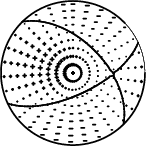
|
|
Figure 1. Waveform inversion focal mechanism
|
The best fit as a function of depth is given in the following figure:
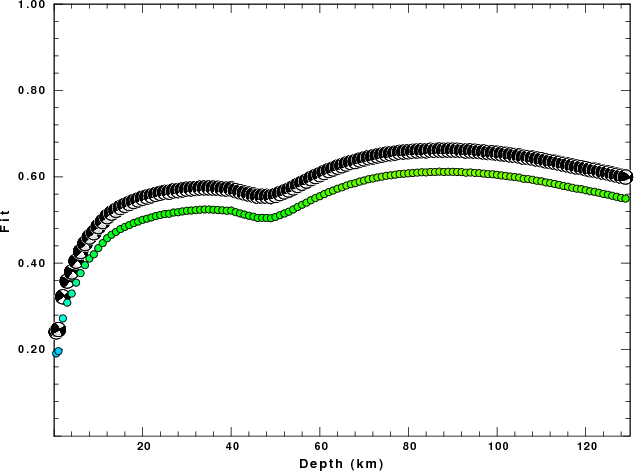
|
|
Figure 2. Depth sensitivity for waveform mechanism
|
The comparison of the observed and predicted waveforms is given in the next figure. The red traces are the observed and the blue are the predicted.
Each observed-predicted component is plotted to the same scale and peak amplitudes are indicated by the numbers to the left of each trace. A pair of numbers is given in black at the right of each predicted traces. The upper number it the time shift required for maximum correlation between the observed and predicted traces. This time shift is required because the synthetics are not computed at exactly the same distance as the observed, the velocity model used in the predictions may not be perfect and the epicentral parameters may be be off.
A positive time shift indicates that the prediction is too fast and should be delayed to match the observed trace (shift to the right in this figure). A negative value indicates that the prediction is too slow. The lower number gives the percentage of variance reduction to characterize the individual goodness of fit (100% indicates a perfect fit).
The bandpass filter used in the processing and for the display was
hp c 0.02 n 3
lp c 0.06 n 3
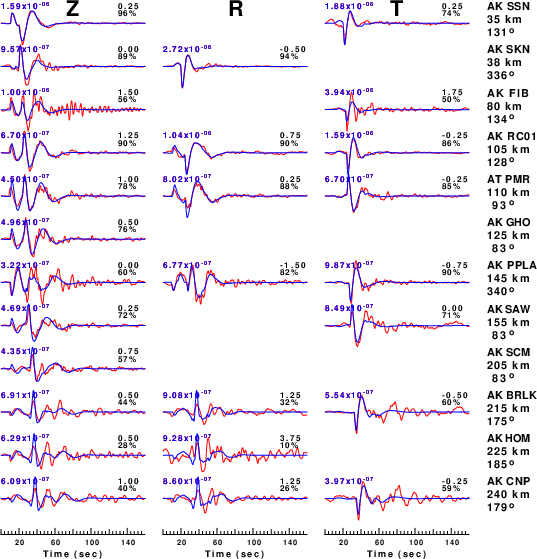
|
|
Figure 3. Waveform comparison for selected depth. Red: observed; Blue - predicted. The time shift with respect to the model prediction is indicated. The percent of fit is also indicated. The time scale is relative to the first trace sample.
|
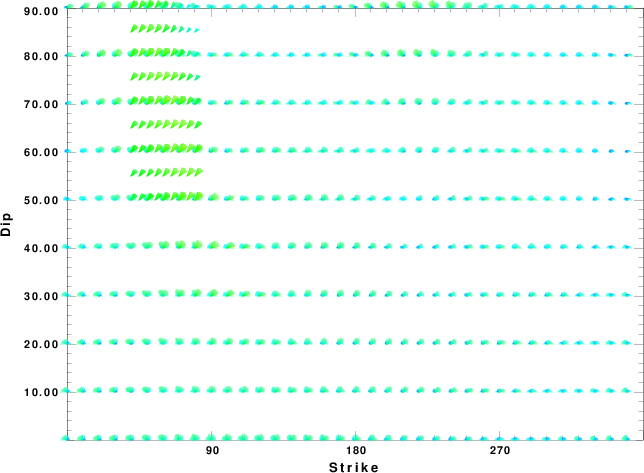
|
|
Focal mechanism sensitivity at the preferred depth. The red color indicates a very good fit to the waveforms.
Each solution is plotted as a vector at a given value of strike and dip with the angle of the vector representing the rake angle, measured, with respect to the upward vertical (N) in the figure.
|
A check on the assumed source location is possible by looking at the time shifts between the observed and predicted traces. The time shifts for waveform matching arise for several reasons:
- The origin time and epicentral distance are incorrect
- The velocity model used for the inversion is incorrect
- The velocity model used to define the P-arrival time is not the
same as the velocity model used for the waveform inversion
(assuming that the initial trace alignment is based on the
P arrival time)
Assuming only a mislocation, the time shifts are fit to a functional form:
Time_shift = A + B cos Azimuth + C Sin Azimuth
The time shifts for this inversion lead to the next figure:
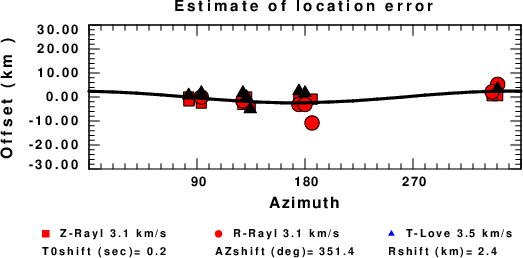
The derived shift in origin time and epicentral coordinates are given at the bottom of the figure.
Velocity Model
The WUS.model used for the waveform synthetic seismograms and for the surface wave eigenfunctions and dispersion is as follows
(The format is in the model96 format of Computer Programs in Seismology).
MODEL.01
Model after 8 iterations
ISOTROPIC
KGS
FLAT EARTH
1-D
CONSTANT VELOCITY
LINE08
LINE09
LINE10
LINE11
H(KM) VP(KM/S) VS(KM/S) RHO(GM/CC) QP QS ETAP ETAS FREFP FREFS
1.9000 3.4065 2.0089 2.2150 0.302E-02 0.679E-02 0.00 0.00 1.00 1.00
6.1000 5.5445 3.2953 2.6089 0.349E-02 0.784E-02 0.00 0.00 1.00 1.00
13.0000 6.2708 3.7396 2.7812 0.212E-02 0.476E-02 0.00 0.00 1.00 1.00
19.0000 6.4075 3.7680 2.8223 0.111E-02 0.249E-02 0.00 0.00 1.00 1.00
0.0000 7.9000 4.6200 3.2760 0.164E-10 0.370E-10 0.00 0.00 1.00 1.00
Last Changed Fri Apr 26 09:40:55 PM CDT 2024


